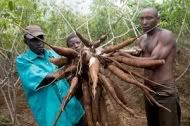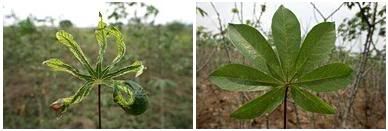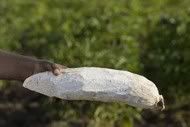FAO reports major success: healthy cassava makes comeback in volatile Great Lakes region
 After years of massive crop losses caused by a devastating virus, farmers are harvesting healthy cassava again - one of Africa's principal foodstuffs - throughout the Great Lakes region, FAO announced, hailing the achievement as a milestone in its ever stronger partnership with the European Union. The successful cassava campaign is good news for the FAO, which is heavily criticized for its incapacity to combat the food crisis and which is undergoing fundamental reform.
After years of massive crop losses caused by a devastating virus, farmers are harvesting healthy cassava again - one of Africa's principal foodstuffs - throughout the Great Lakes region, FAO announced, hailing the achievement as a milestone in its ever stronger partnership with the European Union. The successful cassava campaign is good news for the FAO, which is heavily criticized for its incapacity to combat the food crisis and which is undergoing fundamental reform.By the last planting season, virus-free cassava planting material had been distributed to some 330,000 smallholders in countries struck by the virus: Burundi, the Democratic Republic of Congo, Rwanda and Uganda. The improved crop now benefits a total of some 1.65 million people, and its uptake will speed up further.
Having cassava back on the table is of major importance, especially to the region's most vulnerable, who have been hit hard by the recent upsurge in food prices, said Eric Kueneman Chief of FAO's Crop and Grassland Service. He added that boosting the production of local crops like cassava is a pillar of FAO's response to the current crisis, which was caused by commodity speculation.
In the Great Lakes region though, high prices of food and fertilizer are just part of the problem. As the recent violence in eastern DR Congo tragically demonstrates, the region is still grappling with peace. But, especially under circumstances of extreme instability, cassava can make a crucial difference.
Cassava roots can be harvested whenever there is a need, or left in the ground when farmers are driven from their land. Also, cassava is not an easy prey, when land is unattended: thieves will find it very difficult to dig it from the ground.
Disease causes food shortage

Each person in Africa eats around 80 kg of cassava per year. So, when an aggressive strain of a virus called Cassava Mosaic Disease (CMD) decimated harvests throughout the Great Lakes region, consequences were disastrous.
In Uganda, for instance, where CMD has destroyed 150,000 hectares of cassava since the early nineties - a loss estimated at $US 60 million per annum - food shortages resulting from CMD led to localized famines in 1993 and 1997. CMD appeared in Burundi in 2002. Yield losses attaining ninety percent were record. Prices sky-rocketed. And it came right on top of a devastating civil war. According to FAO’s 2006 State of Food Insecurity in the World (SOFI) report, undernourishment affected two-thirds of the population in 2001/3, compared to less than half before hostilities begun ten years earlier.
Tackling the epidemic began with a series of disease-free varieties developed by one of FAO's research partners, the International Institute of Tropical Agriculture in Nigeria, which were multiplied in nurseries of a multitude of partners, including national research institutions, local governments and civil society, eventually producing enough planting stakes for mass distribution to the population.
Salvator Kaboneka, an FAO agronomist, explains how it all began on “the mother plantation,” as he calls it, a cassava field in Mparambo, not far from Munyika. Here, on 20 hectares, FAO started planting disease free stems in 2005, initially with Belgian and American support.
Every cassava plant provides at least ten usable cuttings. At that rate, it will take only one more year to replant the 84,000 hectares of cassava this country had prior to the arrival of CMD. The mathematics are as simple as they are striking. The original 20 hectares have grown to 1600. Multiplied by ten, that will be 16,000 after the coming season, and 160,000 by the end of 2008.At the same time, FAO embarked on a campaign to boost the capacity and efforts of individual countries in the region, launching a regional cassava initiative in 2006 with funding of several donors led by ECHO - the European Union's humanitarian aid agency - , which has contributed € 3.3 million to FAO's different cassava operations since:
 energy :: sustainability ::biomass :: bioenergy :: ethanol :: cassava :: manioc :: food security :: Africa ::
energy :: sustainability ::biomass :: bioenergy :: ethanol :: cassava :: manioc :: food security :: Africa :: Diner's ready
Burundi's northern Cibitoke province lies in the epicentre of the CMD epidemic. Its fields, barren until a year ago, now bustle with green from cassava leaves. "It's sweet, not bitter," says Ernest Nduwimana, a young farmer who lost his father during Burundi's civil war, holding up a huge cassava root he has just unearthed.
The crop was good this year, Ernest says. There is enough to feed his family until the next harvest, which he is already preparing to plant with quality cuttings from his own cassava plants. Then, after a long day, he returns home, where his mother has prepared bugari, a local dish based on cassava flour and served with beans and fish.
EU support
The European Union is one of FAO's most steadfast and generous partners in promoting sustainable rural development to improve the lives of the poor, contributing over US$ 100 million to FAO's field programme in 2007.
Working together on the ground in developing countries worldwide, improving food security in emergencies, employing research to foster food safety and quality, stimulating information-gathering to build policy, sharing know-how and involving partners in policy-making, the EU and FAO fight poverty at its root.
Cassava's potential: food and fuel
At a global conference held recently in Gent, Belgium, the FAO together with cassava scientists and food security analysts called for a significant increase in investment in research and development to boost farmers’ yields of cassava and explore promising industrial uses for the crop, including production of biofuels.
The tropical root crop could help protect both the food and energy security of poor countries now threatened by soaring food and oil prices, the congress concluded. The FAO reiterated what many tropical agronomists and development experts have said about cassava in the past (e.g. CIAT thinks cassava ethanol could benefit millions of the world's poorest farmers).
The scientists, who have formed an international network called the Global Cassava Partnership (GCP21), said the world community could not continue to ignore the plight of low-income tropical countries that have been hardest hit by rising oil prices and galloping food price inflation.
According to them, cassava has a very large potential as a food and industrial crop: at present, average yields are barely 20% of what they should be under optimum conditions and with basic inputs. The crop grows well on poor, degraded soils and in a vast agro-ecological zone.
 Cassava is also the cheapest known source of starch, and used in more than 300 industrial products. One promising application is fermentation of the starch to produce ethanol used in biofuel, although FAO cautions that policies encouraging a shift to biofuel production should carefully consider its effects on food production and food security.
Cassava is also the cheapest known source of starch, and used in more than 300 industrial products. One promising application is fermentation of the starch to produce ethanol used in biofuel, although FAO cautions that policies encouraging a shift to biofuel production should carefully consider its effects on food production and food security.Cassava field residues and processing waste - such as peels, mill effluent, and the crop's woody stems - could be converted into biogas, biohydrogen or solid biomass for electricity production.
International Institute of Tropical Agriculture
(IITA) is an international non-profit R4D organization since 1967 supported primarily by the CGIAR.
The regional campaign to combat CMD was developed with technical support of FAO’s Crop and Grassland Service. The service helps FAO member countries achieve sustainable increases in production of crops and grasslands, through plant improvement, application of plant biotechnology, development of integrated production systems, and rational grassland management.
The Global Cassava Partnership for Genetic Improvement (GCP21) is an international alliance of research institutions dedicated to increase research and funding on cassava, and dedicated to develop several biotechnological tools to permit breakthroughs in the coming years, to double the cassava productivity in a 15 year time frame.
ECHO is the European Commission Humanitarian Aid agency, and one of the FAO's most loyal partners.
References:
FAO: Cassava’s comeback - November 13, 2008.
FAO: Cassava for food and energy security - July 25, 2008.
FAO: Ernest’s dream: Farmers in Burundi are planting cassava again, with EU/FAO support - 2007
Biopact: FAO calls for boost to cassava R&D for biofuels and food - 'enormous' potential - July 26, 2008
 --------------
--------------
 Taiwan's Feng Chia University has succeeded in boosting the production of hydrogen from biomass to 15 liters per hour, one of the world's highest biohydrogen production rates, a researcher at the university said Friday. The research team managed to produce hydrogen and carbon dioxide (which can be captured and stored) from the fermentation of different strains of anaerobes in a sugar cane-based liquefied mixture. The highest yield was obtained by the Clostridium bacterium.
Taiwan's Feng Chia University has succeeded in boosting the production of hydrogen from biomass to 15 liters per hour, one of the world's highest biohydrogen production rates, a researcher at the university said Friday. The research team managed to produce hydrogen and carbon dioxide (which can be captured and stored) from the fermentation of different strains of anaerobes in a sugar cane-based liquefied mixture. The highest yield was obtained by the Clostridium bacterium.








1 Comments:
Very interesting and far reaching "discoveries" have been made by CIAT since 2006, analyzing genetic resource diversity, regarding variation in cassava starch composition. First, amylose can vary from ca. 18 to 23%. Second, an amylose-free mutant has been identified. These new results need to be mentioned, as they at least suggest a capacity for cassava to compete with maize on the starch market, with one major difference: cassava starch can benefit the poor. For more information: http://www.ciat.cgiar.org/yuca/pdf/report_2007/output_2.pdf
Post a Comment
Links to this post:
Create a Link
<< Home